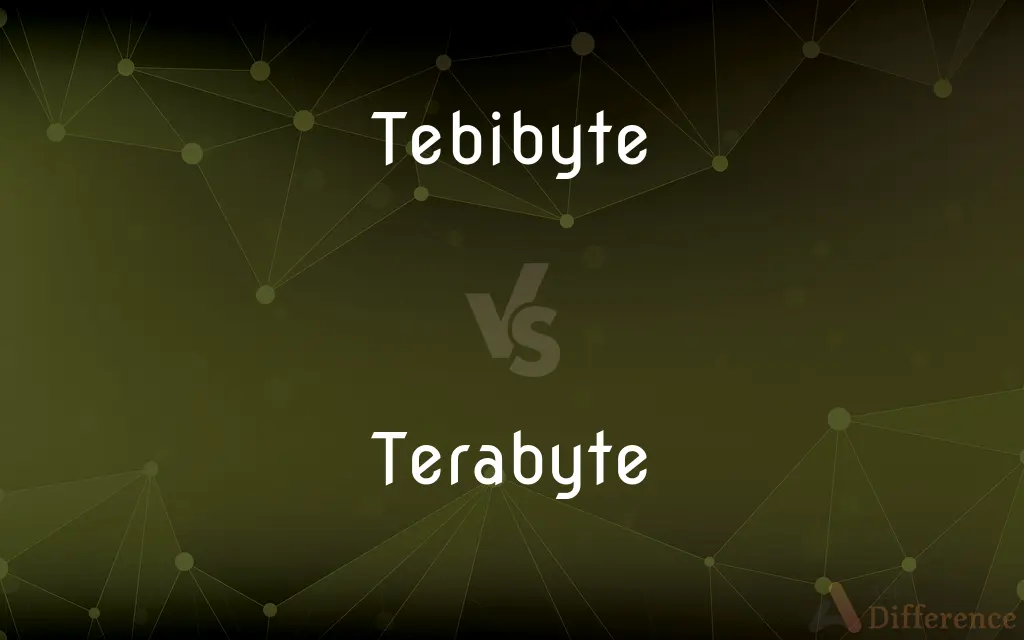Tebibyte vs. Terabyte — What's the Difference?
Edited by Tayyaba Rehman — By Fiza Rafique — Updated on March 26, 2024
A tebibyte (TiB) is a unit of digital storage measured in base 2, while a terabyte (TB) is measured in base 10, making 1 TiB larger than 1 TB.

Difference Between Tebibyte and Terabyte
Table of Contents
ADVERTISEMENT
Key Differences
A tebibyte (TiB) is a measurement unit used in computing to represent 2^44 or 1,099,511,627,776 bytes, adhering to the binary system. On the other hand, a terabyte (TB) represents 10^12 or 1,000,000,000,000 bytes, which is grounded in the decimal system. This difference in base calculation stems from their respective uses, with the tebibyte often found in operating systems and the terabyte commonly used in marketing storage devices.
The distinction between tebibyte and terabyte became more pronounced as storage devices increased in capacity. While a terabyte is traditionally used to denote storage capacity in a more accessible, decimal-based form, a tebibyte provides a more accurate measurement for computing processes that operate in binary.
Moreover, the discrepancy between these two units may cause confusion among consumers, who might not realize that a hard drive marketed as 1 TB actually provides less usable space when viewed through an operating system that reports in tebibytes.
In addressing this confusion, industry standards have slowly shifted towards clearly distinguishing between these two measurements in product specifications. However, legacy practices and general consumer familiarity continue to make terabytes a common term in advertising.
Despite these efforts, understanding the practical implications of this difference is crucial for anyone involved in data storage, computing, or purchasing digital storage devices. It ensures that expectations align with reality, especially in contexts where precision in data capacity is critical.
ADVERTISEMENT
Comparison Chart
Base
Binary (base 2)
Decimal (base 10)
Bytes
2^44 or 1,099,511,627,776 bytes
10^12 or 1,000,000,000,000 bytes
Usage
Computing and operating systems
Marketing and storage devices
Consumer Impact
May result in perceived "loss" of storage space
Often leads to simpler, but less precise, storage capacity figures
Accuracy
More accurate in binary-based computing environments
Less accurate in computing, but simpler for general understanding
Compare with Definitions
Tebibyte
A unit of digital storage equal to 2^44 bytes.
Modern operating systems might require several tebibytes of storage for comprehensive data management.
Terabyte
A unit of digital storage equal to 10^12 bytes.
The cloud service offers 100 TB of storage for large datasets.
Tebibyte
Reflects the actual amount of data storage in computing.
Your new hard drive has a real capacity of 2 TiB.
Terabyte
Commonly used in marketing storage devices.
External hard drives are often advertised in terabytes.
Tebibyte
Used to measure storage in a binary context.
The server's capacity is measured in tebibytes to ensure precision.
Terabyte
Easier for general public to understand.
Most consumers are familiar with terabytes as a measure of storage size.
Tebibyte
Represents larger quantities than terabytes in the same numerical value.
A 1 TiB SSD holds more data than a 1 TB SSD.
Terabyte
May result in less usable space than expected.
The 1 TB hard drive shows less space available on the computer.
Tebibyte
Often used in software to report storage sizes.
The file system displays the free space in tebibytes.
Terabyte
Used in settings where binary precision is less critical.
For most home users, a terabyte provides ample storage.
Tebibyte
(computing) Strictly, 240 (10244, or 1,099,511,627,776) bytes or 210 (1024) gibibytes, as opposed to a terabyte.
Terabyte
A unit of computer memory or data storage capacity equal to 1,024 gigabytes (240 bytes).
Terabyte
One trillion bytes. See Usage Note at gigabyte.
Terabyte
One trillion (1012, or 1,000,000,000,000) bytes or 1,000 gigabytes.
Terabyte
A tebibyte.
Terabyte
A unit of information equal to a trillion (1,099,511,627,776) bytes or 1024 gigabytes
Common Curiosities
Where is Tebibyte commonly used?
In computing and operating systems for a more accurate representation of storage capacity.
Where is Terabyte commonly used?
In marketing and describing storage devices to consumers.
Are there standards for using TiB vs. TB?
Yes, industry standards recommend using tebibytes (TiB) for binary measurements and terabytes (TB) for decimal measurements to avoid confusion.
Can the difference between TiB and TB affect storage capacity perception?
Yes, consumers might perceive less storage capacity when their operating system reports in tebibytes compared to the terabytes advertised.
Why is there confusion between TiB and TB?
Due to their similar names and the historical use of "terabyte" in both binary and decimal contexts.
Do all storage devices report in Terabytes?
Most marketing materials use terabytes, but operating systems might report the same capacity in tebibytes, appearing smaller.
Why is a Tebibyte larger than a Terabyte?
Because it is calculated using the binary system, making 1 TiB larger than 1 TB due to the difference in base calculation.
Is one measurement better than the other?
It depends on the context; tebibytes offer precision in computing, while terabytes may be simpler for general understanding.
Why do operating systems use Tebibytes?
Because operating systems work with binary data, making tebibytes a more accurate measure of storage space.
What is a Tebibyte?
A tebibyte is a unit of digital storage that equals 2^44 bytes, following the binary system.
What is a Terabyte?
A terabyte is a unit of digital storage equal to 10^12 bytes, based on the decimal system.
What led to the creation of the term Tebibyte?
The need for clear differentiation between binary and decimal measurements in digital storage.
How can I convert Tebibytes to Terabytes?
By understanding that 1 TiB is approximately 1.1 TB, you can multiply the number of TiB by 1.1 to estimate in TB.
How does the difference impact everyday computing?
It primarily affects perceptions of storage capacity and the calculation of storage needs.
Should consumers be aware of the difference?
Yes, especially when purchasing storage devices, to set realistic expectations about capacity.
Share Your Discovery

Previous Comparison
Current vs. Ongoing
Next Comparison
Miss vs. MizAuthor Spotlight
Written by
Fiza RafiqueFiza Rafique is a skilled content writer at AskDifference.com, where she meticulously refines and enhances written pieces. Drawing from her vast editorial expertise, Fiza ensures clarity, accuracy, and precision in every article. Passionate about language, she continually seeks to elevate the quality of content for readers worldwide.
Edited by
Tayyaba RehmanTayyaba Rehman is a distinguished writer, currently serving as a primary contributor to askdifference.com. As a researcher in semantics and etymology, Tayyaba's passion for the complexity of languages and their distinctions has found a perfect home on the platform. Tayyaba delves into the intricacies of language, distinguishing between commonly confused words and phrases, thereby providing clarity for readers worldwide.














































